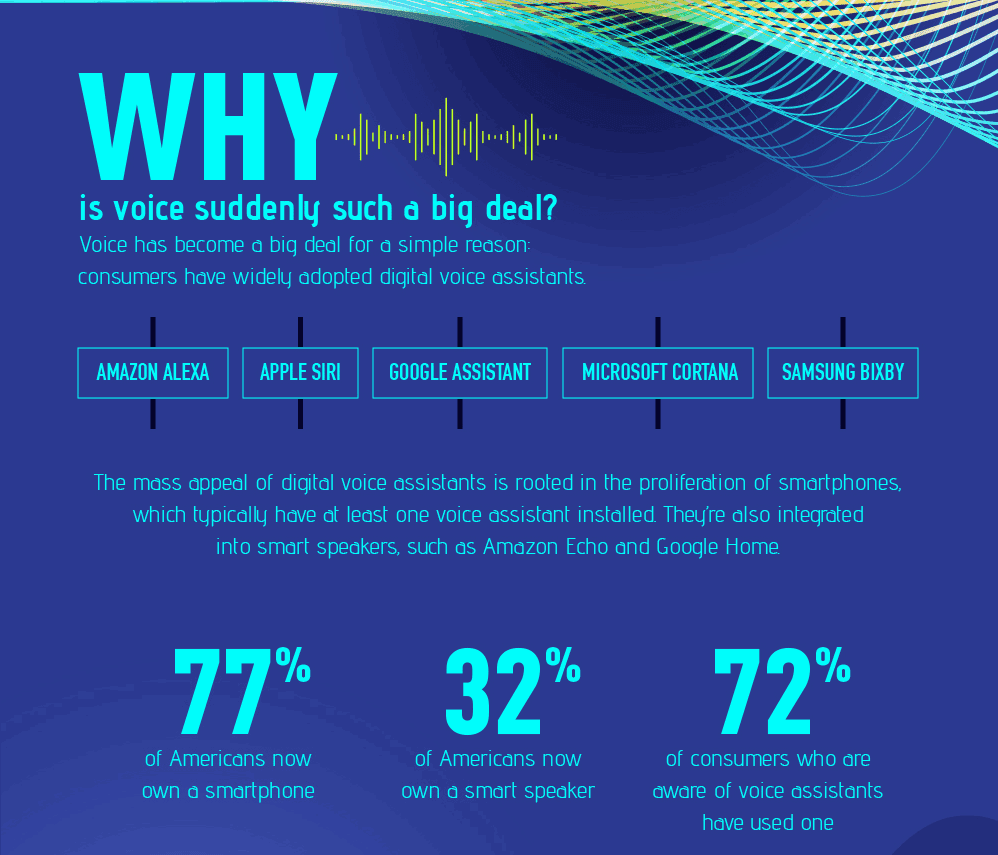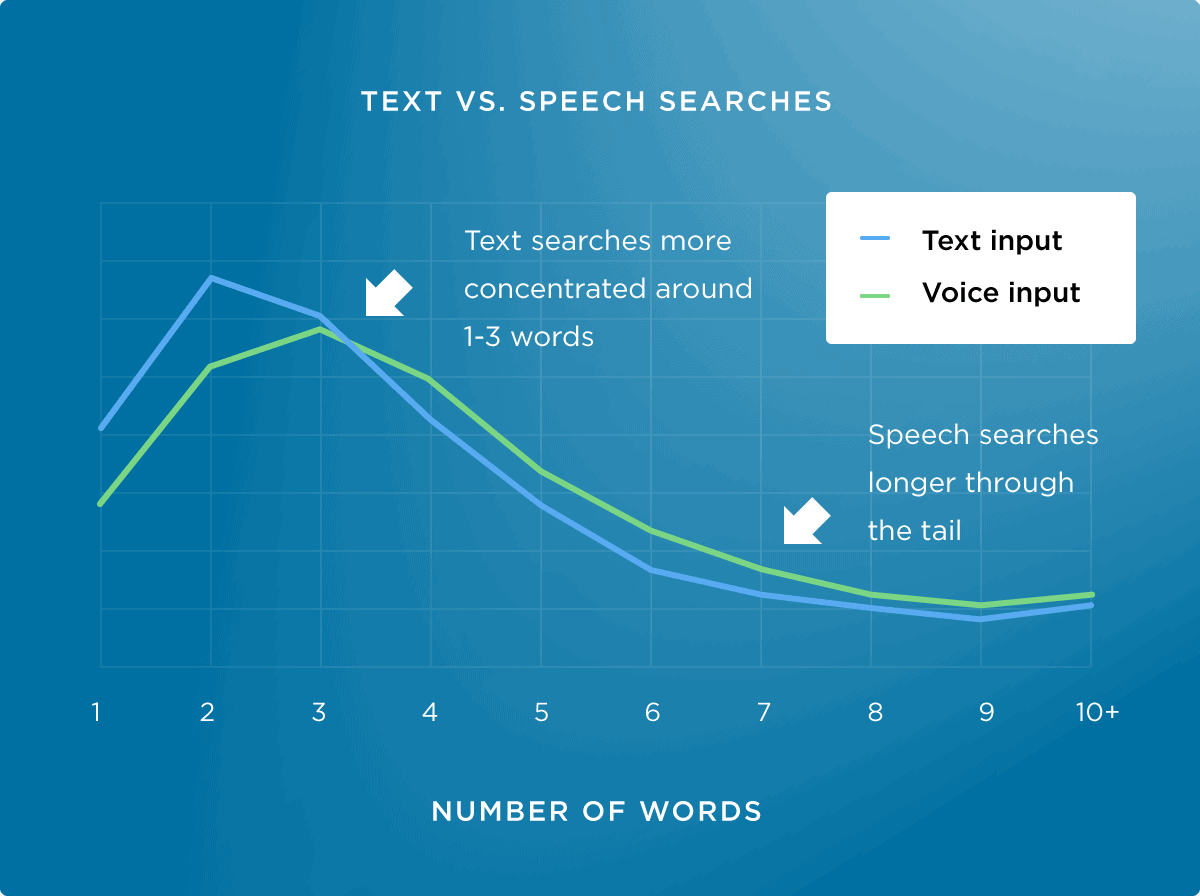Have you ever heard of browsing information digitally without a screen? It’s possible. How? Voice Search.
Voice search has revolutionised how we interact with technology, transforming our spoken words into powerful tools for retrieving information from search engines. With the advancement in Natural language processing and speech recognition technologies, it has transcended as an integral part of our daily lives. Its ability to easily access information, make hands-free commands, and navigate the digital landscape enhances the convenience. It reshapes human-computer interaction, leading to a new path in a digital era.
Voice search is drastically surpassing traditional information searches. Do you know? The Google voice queries have been 35 times increased in 2016 compared to 2008, followed by 50% in 2020. And Behshad Behzadi at SMX West reports that 55% of teens and 41% of adults use it daily.

Voice Search VS Text Search
Voice search is getting more popular daily with increasing usage statistics over Text search. The significant differences between the above two form a base for separate strategies for voice search optimisation. It majorly differs from text search due to,
- Question-based searches
- Long-tail keywords
- Local searches
- Personalisation
- Answers in a featured snippet
- Multiple languages

Its advantages such as user convenience, faster information retrieval, multilingual and accent friendly, natural language processing, integration to mobile, accuracy of results, contextual understanding, etc., make it superior these days. Let’s have a look at some key statistics about its perks.
- According to a PwC report,
71%of users prefer voice search over typed search, and over93%of users are satisfied with the accuracy and speed of the voice assistants. - A Backlinko’s study says that a Voice search takes only
4.6 secondsto load a results page compared to a typed search, which takes8.8 seconds. - Statista says the global voice recognition market will reach over
$27.16 billionby2026. - According to the Global Web Index,
20%of mobile searches are voice searches, i.e., 1 in 5 people use it at least once a month.
Automatic Speech Recognition (ASR): How does the voice search work?
Have you noticed the people saying Alexa, Which is the nearest pizza spot to me? Or which is the best platform for IELTS preparation? Or what is SEO and its key strategies? Have you ever travelled with someone suddenly saying hey Siri, how far is the fuel station to me? And a girl’s voice started coming out of the installed speaker, answering your queries.
Many platforms allow people to use their voice for browsing information online, including
- Microsoft Cortana
- Google Assistant
- Apple Siri
- Amazon Alexa
- Samsung Bixby, etc.
The voice assistive devices include,
- Smartphones
- Google home devices
- Amazon echo devices
- Cortana-enabled devices
- Siri-enabled devices

Do you know how they all work? Understanding the backend operation of voice search is beneficial for planning and updating strategies for SEO, ultimately ranking your website content as VSO results. So, Let’s dive deep into its functionality.
1.) Voice Input and recording
Firstly, the user activates the voice search feature by saying ‘HEY SIRI’ or ‘OKAY GOOGLE’ or ‘ALEXA’ followed by your query question. The signal makes the device start listening and recording the user query. The audio is then either transferred to the server or processed locally.
2.) Speech-to-Text Conversion
The recorded speech is then converted into text through an installed system, i.e., Automatic Speech Recognition (ASR). The ASR system analyses the voice waveform and automatically transcribes it into text form. Sometimes the AI doesn’t understand what you’re saying and suggests the words according to its recognising ability.
3.) Natural Language Processing (NLP)
NLP is a branch of artificial intelligence that helps understand and process human language. The NLP algorithm focuses on text for the structure and grammar of a sentence, keywords in the query, user’s intent, and expected answers.
4.) Query Interpretation
After the NLP analysis, the voice search system interprets the query. It comprehends the user’s intent, the context of the request and other parameters and commands linked to it.
5.) Information Retrieval
The interpreted query is used to search a database or index for relevant information. Web-based video search involves querying search engine indexes to find web pages or information that matches the request.
6.) Ranking and Response
The result is generated based on query relevance and user expectations. It is then presented to the requester as a spoken answer through a smart speaker or a text display in featured snippets on a smartphone screen. It may also execute the requested actions, such as setting an alarm, sending a message, turning on/off smart home devices, and many more.
How to adapt SEO Strategies for Voice Search
Because of several differences between text and voice search, advanced SEO strategies must be planned to respond to user queries efficiently. Do you want to bring your website content under search engine indexing and crawling? Come with me to explore the key points for the best SEO strategies.
1.) Focus on featured snippets and zero-position
The voice assistants usually read information from the featured snippets or zero-position search results. And the content answering the user’s query comes in featured snippets. Altering your website content in a way to be selected for the zero position is a big thumbs-up.
2.) Focus on user-specific content
Do you want to compete for the voice search result? Focusing on the user-specific content may help you accomplish it. Users usually search for personal queries, including words I, Me, You, We, Our, Your, etc. Implementing such possessive nouns or pronouns can bring your content to SE indexing. People also use it for heavy calculations. So, linking online calculators to your content is a solution for answering such requests.
3.) Use long-tail and question-based keywords
The voice searches are usually long conversational and question-based queries. For example, how can I make banana bread at home? Or which is the best smartphone right now? Or what is the best time to wake up? And many more. Utilising questioning keywords, i.e., what is the…, how to…, how can I…, in your articles or blog posts can boost you. Are you curious about how you can do that? Follow me,
- Use Keyword research tools such as Semrush, Similarweb, etc for extracting multiple highly searched but low competitive long keywords. Put these keywords in your content.
- Add the FAQ page on your website, including all the expected questions and their satisfactory answers.
4.) Focus on Local searches
Voice search takes less time, and people usually use it quickly whenever they want to do a local search. For instance, Which is the laptop repair shop near me? or where can I buy a shoulder bag near me right now? Or where I can get the SEO services close to my home, etc. Specific tactics can help answer local searches:
- Consider the local search keywords, i.e., near me, closest to me, in my reach, in 1km, or else, your content benefits you.
- Add the translations of your content in multiple languages to spread the user reach of your brand.
- Put the address of your physical office, brand franchise, hotel, restaurant, etc., on your website attached with the Google map directions.
5.) Use natural language
VS utilises the NLP algorithm for responding to requests. Using words and sentences that sound natural when spoken loud can bring your website content to the top searches. Avoid keyword stuffing and focus on providing valuable content.
6.) Make your website mobile-friendly
Many users do voice searches from mobile phones. Search engines would not rank your website, irrespective of the high quality of your content, if your website isn’t mobile-friendly. The following tactics must be implemented:
- Assess your website in multiple screen frames. Make your website mobile responsive if it’s not.
- Test the website page load speed via Google’s Page-speed insights tool
- Utilise Google’s Accelerated Mobile Page technology to optimise your pages
- Add Alt-text in all of your compressed images
7.) Focus on Social Media optimisation
Users usually search about the trends they see on any social media platform. So, staying active on social media, engaging with the users, and encouraging shares and mentions may help bring your website to top searches.
In the dynamic realm of SEO, the rise of voice search is a transformative force, reshaping the operation of the digital world. As we navigate this revolution, adapting SEO strategies to accommodate voice search becomes not just a choice but a necessity. The journey toward SEO success involving the voice search revolution is ongoing, requiring continual adaptation and innovation. By staying responsive and informed, businesses can position themselves at the forefront of this evolution, ensuring visibility and relevance in the ever-evolving digital landscape.






